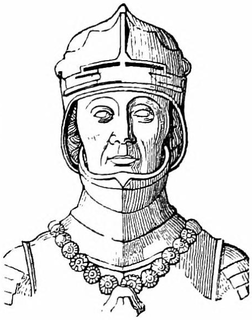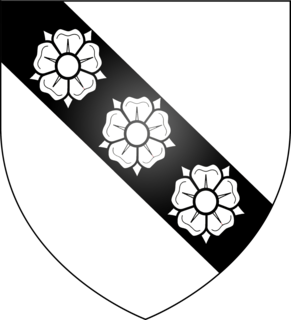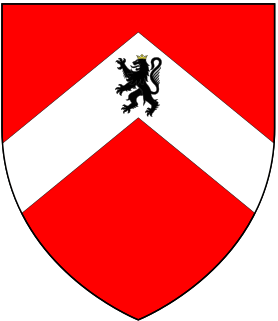
Ralph Neville, 1st Earl of WestmorlandEarl Marshal, was an English nobleman of the House of Neville.
Scrope is the name of an old English family of Norman origin that first came into prominence in the 14th century. The family has held the noble titles of Baron Scrope of Masham, Baron Scrope of Bolton, and for a brief time, the Earl of Wiltshire.
Thomas Chaucer was an English courtier and politician. The son of the poet Geoffrey Chaucer and his wife Philippa Roet, Thomas was linked socially and by family to senior members of the English nobility, though he was himself a commoner. Elected fifteen times to the Parliament of England, he was Speaker of the House of Commons for five parliaments in the early 15th century.
Sir James Pickering was Speaker of the House of Commons of England in 1378 and again from 1382 to 1383. The protestation which, as Speaker, he made for freedom of speech, and declaring the loyalty of the Commons, was the first recorded in the rolls.
Harewood Castle is a 14th-century stone hall house and courtyard fortress, located on the Harewood Estate, Harewood, in West Yorkshire, England. Harewood Castle is a grade I listed building.

Richard de Vere, 11th Earl of OxfordKG was the son and heir of Aubrey de Vere, 10th Earl of Oxford. He took part in the trial of Richard, Earl of Cambridge, and Lord Scrope for their part in the Southampton Plot, and was one of the commanders at Agincourt in 1415.

John Clifford, 7th Baron de Clifford, also known as John, Lord Clifford, 7th Lord of the Honor of Skipton, KG, was an English peer. He was killed at the siege of Meaux, France.
Eleanor Neville was the second daughter of Ralph de Neville, 1st Earl of Westmorland, by his second wife, Joan Beaufort, daughter of John of Gaunt, 1st Duke of Lancaster, and Katherine Swynford.

Sir Thomas de Strickland was an English soldier. He is best known for carrying the banner of St. George at the battle of Agincourt.
Sir Walter Beauchamp was an English lawyer who was Speaker of the House of Commons of England between March and May 1416.

Ralph Neville, 2nd Earl of Westmorland was an English nobleman in northern England.

John Grey, 1st Earl of Tankervillejure uxoris6th Lord of Powys, KG, was an English peer who served with distinction in the Hundred Years' War between England and France under King Henry V.

Sir Richard Vernon was an English landowner, MP and speaker of the House of Commons.
William de Aldeburgh, 1st Baron Aldeburgh was a 14th-century English nobleman and the builder of Harewood Castle.
Robert Waterton was a trusted servant of the House of Lancaster under three monarchs, Henry IV, Henry V, and Henry VI. As Constable of Pontefract Castle, he had custody of Richard II after that king was deposed.

Sir Robert Cary of Cockington, Devon, was twelve times Member of Parliament for Devon, in 1407, 1410, 1411, May 1413, April 1414, Mar. 1416, 1417, 1419, May 1421, 1422, 1425 and 1426. Much of his later life was devoted to regaining the many estates and other landholdings forfeited to the crown following his father's attainder in 1388. He was an esquire in the households of King Richard II (1377–1399) and of the latter's half-brother John Holland, 1st Duke of Exeter.

Richard Stucley, of Merston and Chewton Mendip, was an English landowner, administrator and politician who married an heiress and through his son Hugh, who also married an heiress, became the ancestor of a major Devon family.
John Waterton was an English landowner, administrator, courtier, diplomat, and politician who sat in the Parliament of England.

Sir Gerard de Usflete, (c.1346-1406) of North Ferriby and Ousefleet, Yorkshire, was a Member of Parliament for Yorkshire in 1401.

Sir Thomas Brooke (c.1355-1418) of Holditch in the parish of Thorncombe in Devon and of la Brooke in the parish of Ilchester in Somerset, was "by far the largest landowner in Somerset" and served 13 times as a Member of Parliament for Somerset. He was the first prominent member of his family, largely due to the great wealth he acquired from his marriage to a wealthy widow. The monumental brass of Sir Thomas Brooke and his wife survives in Thorncombe Church.











